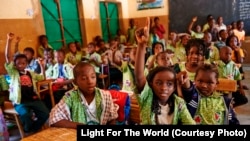A school in Burkina Faso brings together students who might otherwise have a language barrier. The school is called CEFISE, a French acronym for The Integrated Education and Training Centre for Deaf and Hearing People. The institution teaches both hearing and non-hearing students together.
The confederation of NGO’s, Light for the World, says it’s one of the few schools in the world that offers both spoken language and sign language and it promotes CEFISE as “an African school as a best practice example for the North.”
Sign language is the mother language for non-hearing students.
In celebration of the 15th year of International Mother Language Day, this year’s theme has been proclaimed as “Inclusive Education Through and With Language, Language Matters.”
Jess Blijkers, Light for the World’s program coordinator for Burkina Faso, emphasized that inclusive education is life changing for students.
“I think what makes it really unique-- is you feel inclusion as soon as you come in the door. So you have children with and without disabilities just playing in the playground together and you just feel it all around you. So it’s something CEFISE started-- an inclusive school from the very beginning and I think that’s what makes it really special is that they try, and they sort of live the inclusion and live inclusive education,” remarked Blijkers.
She said non-hearing students are encouraged to communicate in their mother tongue which is sign language, so they can further their intellectual and creative development.
“To make that possible, the teachers know sign language. There are sign language interpreters that assist the teachers during the teaching and between the pupils, the hearing pupils also know sign language, so they learn it from a very young age as well, which sort of overcomes this barrier of the hearing and the non-hearing not being able to communicate, not being able to interact,” explained Blijkers.
She highlighted that one can see in the classroom how both the hearing and non-hearing students easily interact with one another.
“A hearing child will help a non-hearing child to understand what is going on in the classroom. So they all learn it together,” said Blijkers.
Inclusive education provides an opportunity for non-hearing students that they may not otherwise have. It offers a young person the opportunity of obtaining an education which can then ultimately lead to employment and more of an independent life for them.
“But it’s beyond that—social inclusion for these non-hearing kids-- to be able to interact with their peers basically whether they’re disabled or not. It’s just an amazing opportunity for social inclusion and for them being more settled, and feeling as if they can really make a contribution to society.”
“I really think that it helps the hearing kids as well--so the non-disabled kids to just have from the very start of their lives a different attitude about disabilities,” she added.












